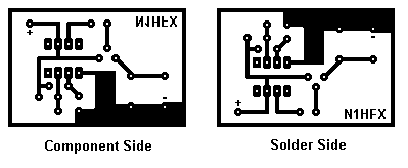
THERMAL COOLING FAN CONTROLLER |
BY N1HFX |
As we begin to enjoy those lazy hazy days of summer, the most important thing on most of our minds is how to keep cool during those hot days. For some of us that means turning up the old air conditioner and sipping on a nice cold glass of our favorite soft drink. However, we often forget about an equally important item and that is how to keep our rigs cool during those long winded summertime QSO's. Until recently, most VHF and UHF transceivers were sold with oversized heat sinks and no cooling fans. Even more surprising is the discovery of the mere 25% duty cycle of many of these radios. Is it any wonder that those RF power amplifier modules have such a high failure rate?
If you own one of those older radios designed before manufacturers finally realized that cooling fans were really needed, help is at hand. The circuit in figure 1 is a thermal cooling fan controller designed around the famous 741 op amp and a simple thermistor. This circuit will control a 12 volt fan requiring as much as 200 MA of current. The thermistor is used as a sensor which turns the fan on whenever the temperature exceeds 88 F. Many of the 12 volt CPU cooling fans will work just fine. Simply attach the cooling fan to the rig's heat sink and place the sensor so that it is in physical contact with the heat sink but not in the fan's air flow. Use tie wraps or some other suitable means to mount the fan and sensor. Experience has shown that soldering can damage or alter the characteristics of the thermistor. Use Butt type crimp connectors to prevent damage from soldering.
The thermistor, R1, is really the heart of this circuit. At 70 F, the thermistor has a resistance of about 10,000 ohms. As the thermistor heats up, it's resistance decreases until the voltage threshold determined by R4 is reached. At this time the output of the op amp goes from high to low causing transistor Q1 to be saturated and allowing current to flow through the emitter to the collector. Capacitor C1 acts as a filter capacitor reducing fan noise as well as providing a capacitive start for the motor. Do not omit C1 in this circuit. The value of C1 may need to be increased if fan noise becomes audible in your rig's receiver. If you would like the fan to turn on at a different temperature or can't find an 8.2K resistor in your junk box then replace R4 with a 10K trimmer pot.
DE N1HFX


